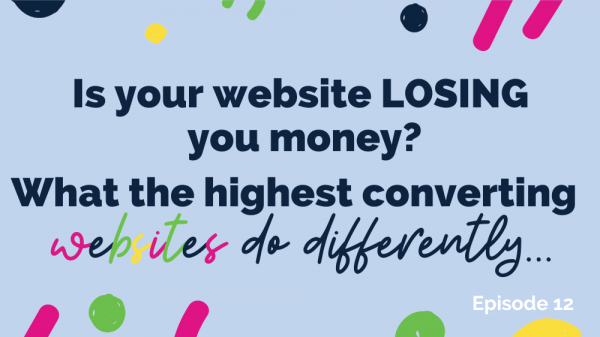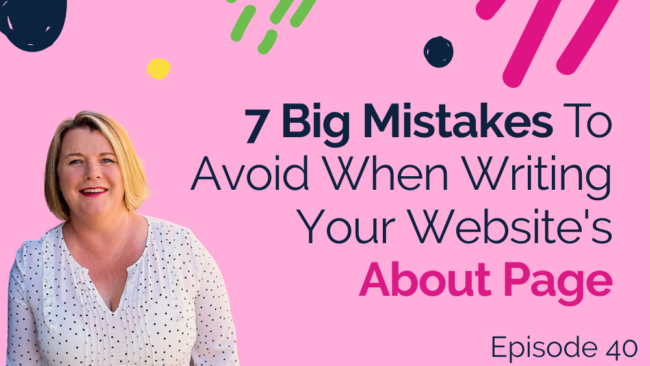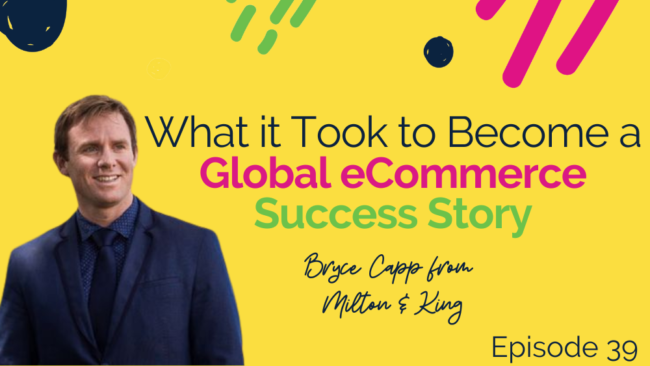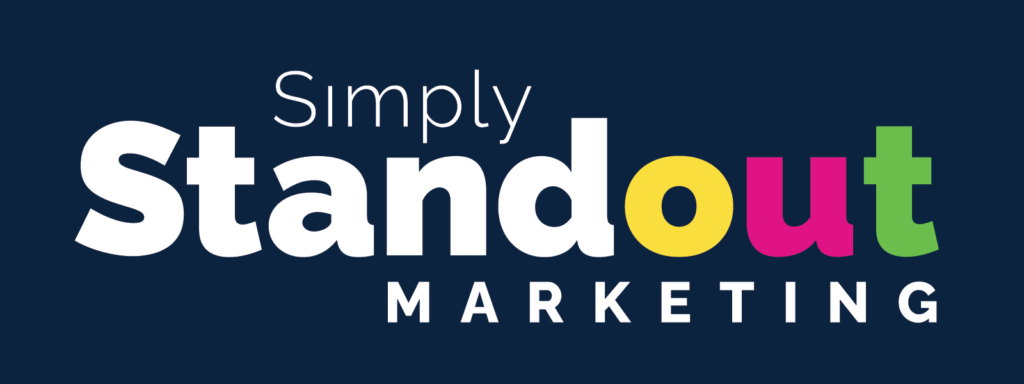Did you know that up to 97% of your website visitors, leave your site without ever taking action? Because it’s one thing to attract visitors to your website, but it’s another to convince them to stay and take action.
So today I’ll let you in on a few secrets about the anatomy of a high converting website, so that you can stop losing customers and start generating more sales.
In this episode you’ll hear:
- What most small businesses get wrong with their websites that cause their visitors to leave without taking action
- The simple steps you need to take to turn your website into a lead generating machine
Resources
Share The Love
If you love what you’ve heard, please share this podcast with your friends, family, and colleagues. Support the show by taking some time to leave a review at https://ReviewThisPodcast.com/SSOMPodcastW.
Thanks! And a big thank you to Mini Sandcrabs for their lovely review:
“I loved every minute of the episodes I listened to. So many “ah ha” moments. A must for any small business!”
Podcast Transcript: Anatomy Of A High Converting Website
Did you know that up to 97 percent of your website visitors leave your site without ever taking action because it’s one thing to attract visitors to your website, but it’s another to convince them to stay and take action. So today, I want to let you in on a few secrets about what the highest converting websites do differently so that you can stop losing customers and start generating more sales. Stay tuned.
Hello and welcome to Episode 12 of the Simply Standout Marketing Podcast. Today we’re talking about the parts of your website that you need to get right in order to stop leaving money on the table and start generating more sales. Having a fantastic looking website does not guarantee success or that you’ll actually grow your business even if you paid a designer handsomely to put it all together. In fact, it might just be the one thing keeping you stuck. Most small business owners believe that the best way to attract more customers is through having a website.
I understand why you think that, because in theory that should be the case. But when you think about it, if that were true, then everyone who had a website would be successful and be the number one in their space. But almost every business nowadays has a website, so simply having a professional looking website isn’t going to make you a success. Instead, there are a combination of things that will make all the difference as to how many enquiries and sales you get. And so often I find small businesses get these things wrong.
Before I start telling you about what you need to do to achieve bigger results from your website, I want you to take a look at what a defective website is really costing you. What do you need to do is go into your Google Analytics account and look at the number of website visits you’ve had in the last, say, 12 months. Then compare that to the number of enquiries and transactions you’ve processed for the same period.
Consider if you improve that conversion rate by even two percent or even five per cent, what would that mean for your bottom line? With that in mind, let’s get started on what you should be concentrating on improving on your website so that you can generate more income. The first thing that most small business websites get wrong is their messaging from the header on their home page to the about us page and products or services pages. The messaging doesn’t stand out and differentiate them from the pack.
It’s often not clear what specific problems you solve for your audience, and it’s not captivating or focussed on the user. Most small business websites also miss the crucial part of addressing their audiences objections to purchasing, plus putting front and centre the internal and external results that their audience wants. Because at the end of the day, your messaging has everything to do with making your customers the hero of the story and solving their problems. So if your prospective customers can’t see that you solve their problem in the space of a few seconds, you’ve lost them.
And when I say problem, I’m not just talking about the fact that they’re looking for a vet, a baker or a financial planner. I’m talking about the specifics. Let’s compare, say, the brand messages of a few websites, which are the word you should see in the first frame of the home page when you open it up. If you were looking for women’s boxing classes to help you lose weight and get fit and you came across one where the first words you read are punch it up, ladies boxing classes, and then you compare it to the next website in your search process that says boxing fitness classes for women, lose weight, have fun, get fit and feel fabulous, which would captivate you and make you want to read more.
Or what about if you were trying to find a holiday house to rent? The first thing you’d see pre covid on Airbnb was welcome home rent unique places to stay from local hosts in 190 countries. Or if you landed on their competitor stays, you’d see beach house, cottage, apartment find the perfect holiday rental. Which one of these stands out to you and speaks to you and solves your problems. Airbnb’s messaging differentiates them from the hundreds of other accommodation booking sites, whereas stays in that instance is no different.
There’s so much more that goes into messaging than you’d think. It’s not a matter of saying you’re the leading business with the best quality and the friendliest staff. Just about everyone says that these days. You need to stand out and speak directly to your audience about both the internal and external problems that they’re looking for solutions for, if you want to learn even more about how to improve your messaging, go back and listen to Episode seven of the podcast titled Why Your Brand Isn’t Getting People’s Attention.
OK, so now you know how important your brand messaging is to getting people to stay on your website and take action. What’s next? Another essential element that high converting websites have, which most others don’t, is that they’re developed as part of a larger marketing and sales strategy. They don’t just talk about the product or service and its features and benefits and then send you to a contact or sales page. They’re created strategically as part of a much bigger plan that ensures that when they send good quality leads to the website from things like they’re advertising, social media or email, the user has a clear and really captivating path, taking them from entry into the website to taking action.
There are clear calls to action on every page. There are lead magnets to entice people to hand over their email address, which are followed by automated email campaigns to build relationships. There are purposeful strategies for people in every stage of buying, including attraction, conversion, retention and referral. And from there, those websites who generate higher conversion rates also test everything. They test the colour on the wording on their call to action buttons on every page, because the little things really do make all the difference.
They test the brand messaging, their office and their images. Look, you’re never going to make everyone happy, but at the end of the day, you shouldn’t be. It’s all about what your best friend, mum and accountant think of your website. It’s about what your ideal customers think and how they act when they’re on it. You need to use the words, the images and style that attracts and converts your ideal customer. Great strategic marketing that works together to create a powerful brand is what is going to allow you to stand out and to grow.
So we’ve talked about fixing your messaging and ensuring your website is developed strategically as part of a bigger marketing plan. And the last piece of the puzzle is improving user experience. When it comes to user experience, one of the biggest reasons people leave your website is because it’s slow to load. Just a couple of seconds is all it takes and makes all the difference between whether they’ll stay or whether they’ll move on. They also leave because the layout and design is off-putting and just isn’t them, or the photos don’t reflect reality and don’t appeal to them.
Sometimes you’ve got too many words, other websites have got too few words and they don’t know what they’re buying. Another thing that puts people off is when videos play automatically. You don’t see it that often now, but it’s still out there. Not only does it slow down page loading, but most people hate it when you take away their control by not asking for consent to play. Also, consider what it looks like from a user’s point of view when you have out-of-date content or an inactive blog.
You’re probably better off if it’s inactive or out of date, taking it down or putting it as a draught so that people can’t see it. You might be surprised to learn how many people look at your website from their phones. Take a look at your website from different mobile devices to see if it has a great user experience. Can people read the text easily, remembering that not everyone has great vision? Mine is definitely getting worse as I get older.
Does the layout work well? Is it super easy to navigate. If you don’t already know the breakdown of what devices people are using when they visit your site, take a look at your Google analytics. Whether you have a local bricks and mortar business or an online business, when 70 to 80 percent of people research online before visiting or purchasing from a small business, it couldn’t be more important to have a high performing website. Now, high performing doesn’t mean it should be complicated.
Consider what high performing websites have in common that you don’t have right now. They understand and communicate what’s unique about them that will drive eyeballs. They have prioritised getting their messaging spot on so that it makes their customer the hero and speaks directly to them. They communicate the true value they bring to the customer. Their website is developed strategically in combination with all their other marketing, and their user experience is fantastic, which means their users are happier to stay on their site for longer.
As you’ve heard, there are a number of things you can do to achieve a better and much bigger results from your website. So now it’s time for you to put all of this into action. If you don’t know where to start or you need help with making it happen, the great news is we’ve created the perfect framework that can help you turn your website into a lead generating machine. So get in contact with me if you need help.
Thanks so much for listening. I hope you’ve got some great value out of today’s episode and will take what you’ve learnt and put it into action.
Thanks for listening to the Simply Standout Marketing Podcast, head over to simplystandoutmarketing.com for the show notes, downloads and even more great stuff to help you grow your business with marketing made simple.




